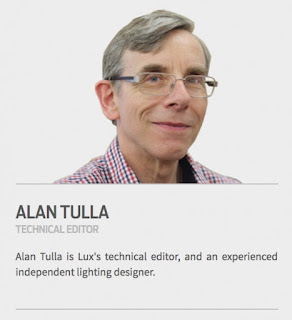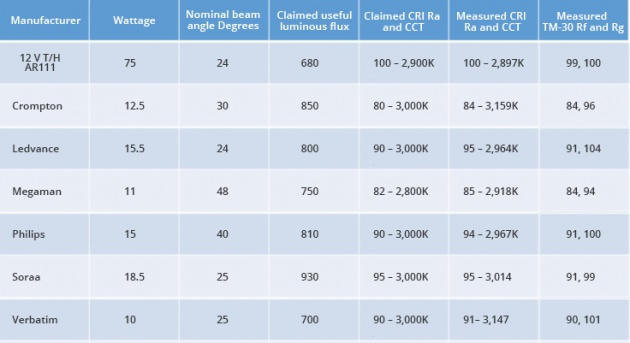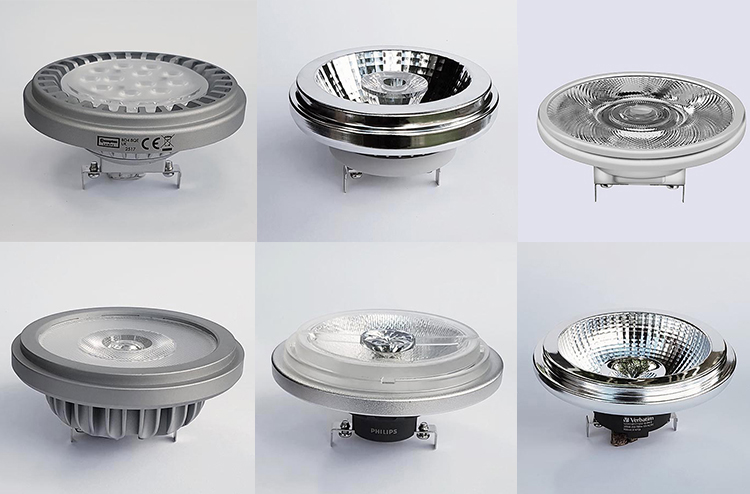
Lux reports: These LED retrofits are designed as energy saving replacements for the original tungsten halogen filament lamps. The AR111 filament lamp is usually 12V and, unsurprisingly, 111 mm diameter.
The lamps reviewed here are designed specifically as retrofit. I.e. they have an integral driver in the base. There are some LED AR111 suppliers whose lamp is only supplied suitable for luminaires with a dedicated, remote driver.
The reason for developing a large diameter reflector lamp was to achieve a tightly controlled beam which could be used for display lighting. Having a 12V filament meant you had almost a “point source” in terms of optics.
These LED replacements, therefore, need to have a good quality beam (no hot spots or striations) and excellent colour rendering. All the lamps have a CRI >80. We asked for lamps with a beam between 20° and 40°. Display lighting often requires a very narrow beam and you should check what is available from the manufacturer.
When we refer to a beam angle, we mean the total width at which the intensity is half the peak. E.g. a 40° beam is a cone of 20° around the central axis. Some manufacturers quote the angle either side of the axis. This makes the beam seem to be half the width it actually is. Labelling regulations say that the packaging should quote the lumen value inside a 90° cone. This is known as ‘useful luminous flux’ and should be marked on the box.
In order to test the colour quality, we sent the lamps to the laboratories at University College London for independent testing and comparison. Thanks go to Peter Raynham, the course director of the MSc in Light and Lighting and Janine Stampfli, the MSc student who conducted the testing.
The LED lamps were compared with a 75W AR111 halogen filament lamp and the CIE CRI and TM-30 Indices.
One final point: you need to check that the retrofit lamp will physically fit inside the luminaire. There have been some cases where the LED version is too large – this is often caused by the size of the heatsink.
Summary
It is interesting to see that the CIE CRI Ra which is based on eight pastel colours gave a good indication of colour rendering compared with the much more detailed and informative IES TM-30 which is based on 99 colours of all shades and saturation.
The Colour Vector Graphic is much more useful because you can easily see the deficiencies and strengths compared with the reference source even though it doesn’t have any numbers attached to it.
One last point that is often forgotten is that the only reason incandescent lamps have a CRI of 100 because they are also used as the reference source. Apart from its familiarity, you wouldn’t really want a light source so deficient at the blue end of the spectrum.

Crompton
This lamp has a nice looking beam with soft edges. Like another of the lamps reviewed, about 8% of the light falls outside a 90° cone. This means you get a bright centre with extra light for the ambient surroundings.
In appearance, there is an attractive outer rim with cooling “ribs/fins”. This spoilt somewhat by the central frosted plastic moulding where the 12 yellow LED chips can clearly be seen.
- Lux rating:
3 STARS

LEDVANCE
This Osram lamp from LEDVANCE most probably gives the nicest beam. It is uniform from the centre to the edge with no sharp cut-off.
The aluminium reflector is quite shallow and, like the other lamps, has diamond shape facets. The front of the lamp is completely sealed by a clear plastic lens. This has the advantage that the reflector would stay clean throughout its life.
- Lux rating:
5 STARS

Megaman LED Reflector
This has a facetted aluminium reflector with a clear prismed plastic cone in the centre to direct the light.
We tested the 48° version and the centre of the beam is nice and clean. However, the overall beam is very wide with 15% of the lumens being emitted outside 90°.
- Lux rating:
3 STARS

Philips Master LEDspot
This is a nice looking lamp and the front face looks almost exactly like the filament version. The concave reflector looks metallic although it is actually heavily prismed clear plastic. There is also a clear conical prism directly above the light source.
The beam is uniform from centre to the edge and there is only the slightest wooliness to the cut-off.
- Lux rating:5 STARS

Soraa Vivid
When I asked one well-known lighting designer which AR111 she specifies, she simply said “Oh, I just go straight to the top and specify Soraa”.
One aspect of Soraa lamps that designers particularly like is the range of snap on lenses. These can be used to adjust the beam width or change the colour temperature, CCT and can be done easily even after installation. If the layout of the shop changes, you can simply use another snap on lens.
- Lux rating:5 STARS
Verbatim
 As mentioned in the introduction, you need to check that the retrofit LED lamp will physically fit the luminaire. Verbatim are proud of their optimised thermal design which means it is shallower in depth than many other lamps.
As mentioned in the introduction, you need to check that the retrofit LED lamp will physically fit the luminaire. Verbatim are proud of their optimised thermal design which means it is shallower in depth than many other lamps.
It is also the most realistic looking lamp. There is no front cover, the reflector is all aluminium and there are no plastic mouldings in the centre. The beam is also good with no unevenness.
- Lux rating:
5 STARS
Test results

Visit Novel Energy Lighting to buy these brands of LED AR111 at very competitive prices!
crompton led ar111 · LED AR111 · megaman led ar111 · Novel Energy Lighting · osram ledvance led ar111 · philips masterled ar111 · soraa led ar111 · verbatim led ar111
Comments are closed.
<< Helsinki’s smart street lights will find you a parking place


